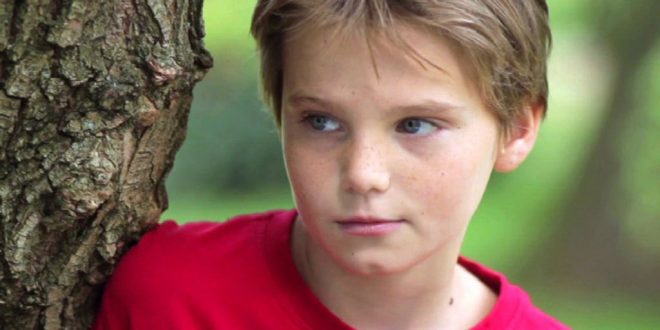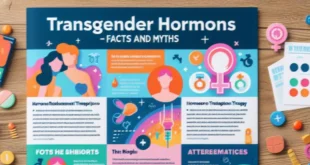At the age of 3, Simon was playing with tea-sets. At 5 he fell in love with Barbie dolls. And at 7 he told his mum: “I wish I’d been born a girl.”
But Pat wasn’t shocked… she already knew there was something different about her eldest son. He never touched boys’ toys and he only ever wanted girls as his playmates.
“As a teacher, I didn’t take too much notice at first, because children will play with whatever’s to hand,” says Pat. ” But it gradually dawned on me that he always went for the girls’ toys. The cars and garages we bought him were left untouched – he preferred to potter around the kitchen with a tea-towel tied around him like a skirt. One day, after I’d dropped him off at nursery school, I peered through the window and saw him playing with a pretty little tea-set.”
By the time Simon was 4, he’d made it clear he only wanted to play with the girls. “He couldn’t play with the boys,”” says Pat. “He had nothing in common with them. He was a very gentle child, so he was always being pushed around… They didn’t understand him.”
Pat and her husband Michael, a solictor, decided to send Simon to a boys-only school in the hope it would toughen him up and make him ‘normal’.
Pat admits: “It was a terrible mistake. Simon was very unhappy – the school was formal and competetive. He was often buliied – and once he was thrown on a rubbish heap. But above all, he missed girls’ company.”
They moved him to a smaller mixed school where he spent two happy years. Then he started secondary school, which was fine at first, especially when he got a part in the school play.
“He loved dressing up especially in girls’ clothes,” says Pat. “He’d raid my cupboards for things to wear. Then he took up dancing classes and won a competition dressed up in frills and feathers. His father sat squirming with embarrassment, although he hid it well from his son.”
But Simon’s happy schooldays didn’t last long. His drama teacher made a comment about his sexuality to a group of older boys… and the bullying started.
“I went up to the school and had it out with the teachers. Simon might be different, but it isn’t up to them to ridicule him. By then I was at my wits’ end.”
And birthday parties were a nightmare – Simon didn’t have any friends. Pat would invite her friends’ children around, but Simon was never invited back to their homes.
“We did our best to protect him. When other kids came round we’d suggest he put away his collection of Barbie Dolls so they wouldn’t tease him. He’d refuse, but he never complained when they took the mickey… He seemed to think it was his lot in life.”
When he was 7, Pat took him for assessment by child psychologists at a London Hospital. But they couldn’t help with the question of Simon’s true gender. “I never had anyone to talk to,” says Pat. “People just didn’t want to know… And there didn’t seem to be any experts I could turn to.”
Pat was at the end of her tether when she heard of a clinic at St. George’s Hospital in Tooting, South London, where an Italian doctor, Domenico Di Ceglie specialises in helping children with gender identification problems. “I was desperate to speak to someone who could help. They were wonderful,” says Pat.
“Boys and girls can sometimes grow up confused about what gender they really are,” says Dr Di Ceglie. “But it’s more noticeable in boys because a tomboyish girl is much more easily accepted than a feminine boy.”
“Research has shown gender problems can be caused by biological, psychological or family factors,” he continues. “It’s difficult to predict early on whether a child will become a transsexual, homosexual, or revert to heterosexual development. But by the early teens, we have a good idea, and by the late teenage years we know for certain.”
“If a boy consitently behaves like a girl, or a girl like a boy, then a professional should be consulted. But the child must be treated sensitively.”
Simon was 11 when he started going to sessions at St George’s. Now 13, he goes to a performing arts school where floaty shirts and jewellry fit in easily. Pat, who lives in Surrey, admits she’s embarrassed about what people must think. “One night, a friend of my other son’s was at the house. His father – who’d never met Simon – came to pick him up. When Simon waltzed in wearing a long velvet cloak and earrings, he asked if it was my daughter. ‘No’ I replied. ‘It’s Simon.’ I don’t know who was more embarrassed!”
But what really haunts Pat is what will happen to Simon eventually. “He doesn’t hate his male body like some boys at the clinic do… And he doesn’t buy girls’ panties. But I look at his make-up, dyed hair and clothes and I’m terrified he’ll be lynched one night.”
Simon’s still too young for anyone to know what his sexuality will be, but his mother knows he’ll have to face many difficult decisions as he gets older.
“It’s sad. People don’t understand,” she says. “But it helps to know he’s not alone – there are hundreds of children like him all over the country.”
“I just don’t know he’d be happier if he’d been born a girl. I only wish I could have been more help to him… by giving birth to him as a girl rather than as a boy.”
by Alix Palmer
From Woman’s Own
mermaids.freeuk.com/woman.html – 2004
 Lesbian, Gay, Bisexual, Transgender & Intersex News Lesbian News, Gay News, Bisexual News, Transgender News, Intersex News, LGBTI News
Lesbian, Gay, Bisexual, Transgender & Intersex News Lesbian News, Gay News, Bisexual News, Transgender News, Intersex News, LGBTI News




